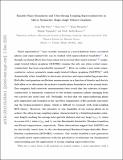Tunable strongly coupled superconductivity in magic-angle twisted trilayer graphene
Author(s)
Park, Jeong Min; Cao, Yuan; Watanabe, Kenji; Taniguchi, Takashi; Jarillo-Herrero, Pablo
DownloadSubmitted version (12.45Mb)
Publisher Policy
Publisher Policy
Article is made available in accordance with the publisher's policy and may be subject to US copyright law. Please refer to the publisher's site for terms of use.
Terms of use
Metadata
Show full item recordAbstract
© 2021, The Author(s), under exclusive licence to Springer Nature Limited. Moiré superlattices1,2 have recently emerged as a platform upon which correlated physics and superconductivity can be studied with unprecedented tunability3–6. Although correlated effects have been observed in several other moiré systems7–17, magic-angle twisted bilayer graphene remains the only one in which robust superconductivity has been reproducibly measured4–6. Here we realize a moiré superconductor in magic-angle twisted trilayer graphene (MATTG)18, which has better tunability of its electronic structure and superconducting properties than magic-angle twisted bilayer graphene. Measurements of the Hall effect and quantum oscillations as a function of density and electric field enable us to determine the tunable phase boundaries of the system in the normal metallic state. Zero-magnetic-field resistivity measurements reveal that the existence of superconductivity is intimately connected to the broken-symmetry phase that emerges from two carriers per moiré unit cell. We find that the superconducting phase is suppressed and bounded at the Van Hove singularities that partially surround the broken-symmetry phase, which is difficult to reconcile with weak-coupling Bardeen–Cooper–Schrieffer theory. Moreover, the extensive in situ tunability of our system allows us to reach the ultrastrong-coupling regime, characterized by a Ginzburg–Landau coherence length that reaches the average inter-particle distance, and very large TBKT/TF values, in excess of 0.1 (where TBKT and TF are the Berezinskii–Kosterlitz–Thouless transition and Fermi temperatures, respectively). These observations suggest that MATTG can be electrically tuned close to the crossover to a two-dimensional Bose–Einstein condensate. Our results establish a family of tunable moiré superconductors that have the potential to revolutionize our fundamental understanding of and the applications for strongly coupled superconductivity.
Date issued
2021Department
Massachusetts Institute of Technology. Department of PhysicsJournal
Nature
Publisher
Springer Science and Business Media LLC
Citation
Park, Jeong Min, Cao, Yuan, Watanabe, Kenji, Taniguchi, Takashi and Jarillo-Herrero, Pablo. 2021. "Tunable strongly coupled superconductivity in magic-angle twisted trilayer graphene." Nature, 590 (7845).
Version: Original manuscript